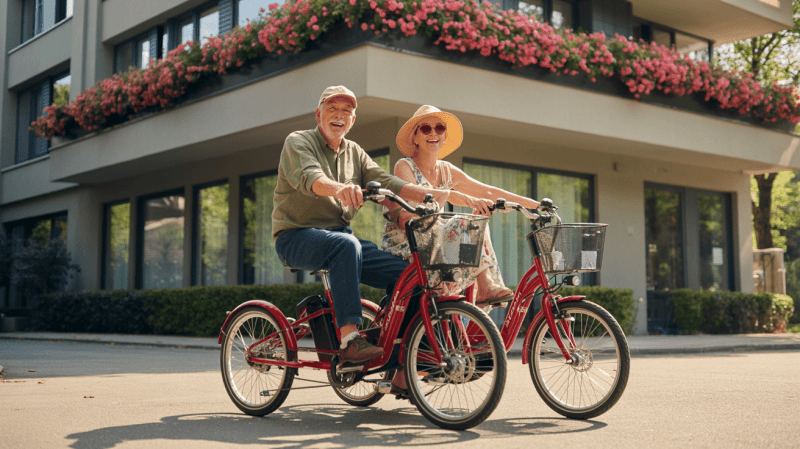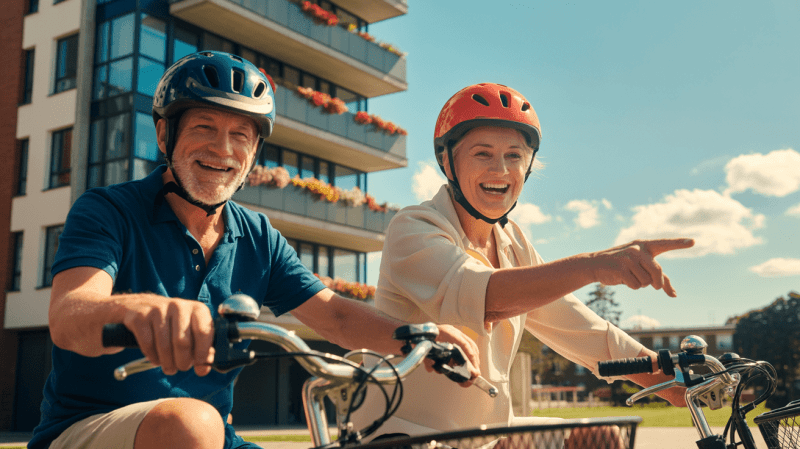"Pedal Power: Building Strength and Endurance in Senior Cycling"

As we age, our bodies naturally start to lose some of their strength and endurance. For seniors looking to keep up an active lifestyle, this can feel like a challenging barrier. But here's the great news: cycling is a fantastic way for older adults to not only maintain but also build physical fitness in a fun and low-impact way.
If you're a senior cyclist or considering jumping into the saddle, understanding how to boost your strength and stamina on two wheels is key.
Did you know? Regular cycling can help increase bone density which tends to decline with age. This means that pedaling isn't just good for your muscles; it's also literally helping to strengthen your bones! In this blog post, we'll explore how incorporating specific training techniques and exercises into your routine can enhance the benefits of senior cycling.
We'll give you tips on staying motivated, managing health conditions effectively, and cross-training strategies that work best for mature athletes.
Ready for a ride toward better health? Keep reading – let’s cycle towards strength!
Key Takeaways
- Cycling is a great low-impact exercise that helps seniors stay fit, with benefits for heart health, muscle strength, bone density, and mental wellness.
- Strength training including heavy lifting and bodyweight exercises can be added to cycling to boost muscle mass and protect bones in older adults.
- Cross-training with activities like swimming or walking improves cardiovascular health and adds variety to prevent workout boredom.
- Specific cycling programs like endurance rides, tempo rides, and intensity interval training increase stamina and make everyday tasks easier for seniors.
- Senior cyclists should manage medical conditions proactively by consulting doctors, following health guidelines, and incorporating safe exercises into their routines.
Understanding the Importance of Cycling for Seniors

Cycling stands out as a powerhouse of an activity, offering seniors a path to rejuvenate both body and spirit. It's not just about staying active; it's the pursuit of sustained wellness that makes every pedal stroke count toward building strength and preserving vitality in later years.
https://www.youtube.com/watch?v=yohOrJHsUKw
Health Benefits of Cycling:
Cycling is a great way for seniors to stay fit and healthy. It's a low-impact activity that can lead to significant benefits for both body and mind.
- Pedaling boosts heart health. It strengthens the heart muscles, lowers resting pulse, and reduces blood fat levels.
- Regular rides improve blood flow. This helps keep your brain sharp and protects against mental decline.
- Your muscles get stronger without stressing your joints. Cycling uses all the major muscle groups as you pedal.
- Bones become denser with dynamic cycling action. This can help fend off osteoporosis.
- Feeling good is part of the ride. Endorphins released during cycling can ease stress, anxiety, and depression.
- Stamina increases over time. You'll find yourself able to do more with less fatigue.
- Social connections grow when you cycle with others. Riding with friends or clubs fights loneliness and keeps spirits high.
Importance for muscle retention and bone density:
Biking not only boosts your heart health but also plays a key role in keeping your muscles strong. Pedaling away on two wheels helps maintain the muscle mass that often decreases with age.
Strong muscles support your joints and ward off injuries, making everyday tasks easier. They keep you steady on your feet, reducing falls and breaks.
Riding a bike also stimulates bones, encouraging density and strength. This can be a game-changer as it battles bone thinness that may come with getting older. With better bone density, you lower the risk of fractures if you take a tumble.
Regular cycling is like giving your skeleton a workout, helping to keep bones tough even as birthdays add up.
Tips for Senior Cycling

For senior cyclists, the road to enhanced strength and endurance is paved with smart strategies; staying active isn't just about pedaling. It's about embracing a lifestyle that acknowledges age but doesn’t concede to it - by continuously finding joy in movement, handling health matters head-on, and pushing beyond previous limits.
Never Stop Cycling:
Keep those wheels turning! Cycling is a gift that keeps on giving, especially as you age. It's key for maintaining your heart health and keeping blood pressure in check. Make riding your bike a regular part of life.
Think of it like brushing your teeth – something you do without fail to stay healthy.
Riding often helps your muscles stay strong and flexible, which means less chance of falling or getting hurt. Your bones will thank you too; cycling spurs bone growth and fights off osteoporosis.
Plus, it sharpens your mind and sweeps away stress. Don't let the bike gather dust—pedal towards better health every day!
Let's shift gears into another essential piece – engaging in youthful activities..
Engage in Youthful Activities:
Try adding some youthful zest to your cycling routine. Mix up your rides with playful challenges or races with friends. These activities can sharpen your reflexes and boost total body coordination.
They keep things fun, too! Hopping on a bike isn't just about getting from point A to point B; it's an adventure that taps into the joy of movement, much like when you were a kid.
Embrace new cycling paths or join a community ride event to infuse energy and excitement into your exercise. Active aging is all about embracing life's possibilities, no matter the age.
Cycling helps maintain muscle strength and bone density which are key for staying mobile and agile. So grab your helmet, push those pedals, and feel the wind in your hair – it's not just good for the body, but great for the soul!
Step Out of Your Comfort Zone:
Engaging in youthful activities is just the start. Pushing past familiar routines pumps new energy into your senior fitness journey. Take on new challenges with cycling—maybe tackle a hill you've eyed but never dared to climb.
Feel the thrill of conquering fears and watch confidence grow. Say yes to rides that seem a bit too long or routes that appear intimidating. Each pedal stroke outside your comfort zone builds not only muscle but also mental toughness and resilience, making every ride an adventure.
Exploring unknown paths can lead to exciting discoveries, both about scenic routes and personal limits. Encourage friends from your cycling club to join you on these explorations; shared experiences bring laughter and bonding, while also providing safety in numbers.
Every push beyond what's comfortable helps maintain mobility and contributes to a happier, healthier aging process alongside fellow cyclists who support each other every mile of the way.
Handle Medical Conditions Proactively:
Stay ahead of your health while cycling. Check with your doctor and listen to their advice carefully. They know how exercise affects your unique medical conditions. Take medications as prescribed, and keep emergency contacts handy, just in case.
Manage illnesses like high blood pressure or heart disease by following health guidelines. This way, you can ride safely and feel good about it.
Taking care of yourself doesn't stop at the doctor's office—exercise strengthens your body, too. Add strength training to cycling for even more benefits for your muscles and bones.
Incorporating Strength Training in Cycling
Integrating strength training into your cycling routine is not just about powering through rides; it's a strategic move to improve overall endurance and vitality—stay tuned for insights on making each pedal stroke count.
https://www.youtube.com/watch?v=ymuQtR_-Loc
Benefits of heavy strength training
Heavy strength training is great for seniors. It makes muscles stronger and helps with daily tasks.
- Builds muscle mass: Lifting heavier weights increases the size of your muscles. This means you can carry groceries, climb stairs, and pick up grandkids without getting tired as quickly.
- Protects bones: Heavy lifting stimulates bone growth. Stronger bones lower the risk of breaks and osteoporosis.
- Boosts metabolism: When you have more muscle, your body burns more calories, even at rest. This can help manage weight and prevent obesity-related illnesses.
- Improves balance and coordination: Strength training requires focus and control. Better balance means fewer falls and injuries.
- Enhances mental health: Working out releases endorphins, which make you feel good. Regular exercise can also help with sleep and reduce anxiety.
- Increases flexibility and mobility: Stronger muscles support your joints better. This makes moving around easier and keeps you independent longer.
Aerobic muscle training
Aerobic muscle training pairs well with cycling, especially for seniors. This type of exercise gets your heart pumping and uses oxygen to burn fat for energy. It makes your lungs work hard, which is great for cardiovascular health.
Exercises like brisk walking, swimming, or even a dance class can count as aerobic training.
Mix these activities with your rides to keep your heart strong and muscles fit. As you cycle and do other aerobic exercises, you'll notice everyday tasks get easier over time. Your endurance will go up, making longer bike rides or climbs less daunting.
Remember to listen to your body and take breaks when needed—this will help you stay active without risking injury or exhaustion.
Cross-Training for Senior Cyclists
Cross-training is a cornerstone of maintaining overall fitness, and for senior cyclists, it's especially beneficial — diversifying your routine not only enhances cycling performance but also fortifies your body against injury; stay tuned to discover how this multi-modal approach can revitalize your rides.
Bodyweight workouts
Bodyweight workouts are great for building strength at any age. They use your own weight to train muscles and improve balance. This kind of workout fits well into a senior fitness routine because it's safe, effective, and can be done anywhere.
These exercises include squats, lunges, and push-ups. They help seniors maintain muscle mass and keep joints flexible.
As you add bodyweight exercises to your cycling program, you'll boost endurance too. Mix them with other activities like walking or swimming for full-body benefits. Start with simple moves and increase difficulty slowly.
Focus on good form to prevent injuries—this is key for aging bodies that need extra care in staying active and healthy.
Core, balance, and stability exercises
Moving from bodyweight workouts, let's focus on exercises that target your core and improve balance. Core strength is essential for everyday activities, cycling included. Strong muscles in your belly and back give you power and protect against falls.
Practice planks to tighten your core. Try standing on one foot, then switch to the other to challenge your balance.
Balance routines are valuable too because they help keep you steady on and off the bike. Use a stability ball or do yoga poses like tree pose for better poise and control. These exercises not only make riding safer but also add confidence in daily life tasks.
Upper-Body Exercises:
Upper-body strength is key for balanced fitness, especially for seniors. Strong arms, shoulders, and chest help with everyday tasks like lifting groceries or reaching high shelves.
To build upper-body muscles without cycling, seniors can try various exercises.
Push-ups are great for working the chest and arms. You can do them against a wall if you need an easier start. Dumbbell exercises also boost strength. Use light weights to perform arm curls or shoulder presses while sitting or standing.
Resistance bands offer another way to target the upper body; pull the bands apart in front of you or above your head for a good stretch.
Always listen to your body and don't push too hard - safety is crucial! Doing these exercises two or three times a week can enhance your overall senior fitness routine by adding that important upper-body component cycling doesn't cover.
Lower-Body Exercises:
Strong legs keep you moving and cycling smoothly. Squats, lunges, and calf raises target your thighs, calves, and glutes. These exercises build up muscles that power your pedal strokes.
Include leg presses in your routine for added strength. They support knee joints and prevent injuries.
Mix these lower-body workouts into your week. You'll feel the difference on rides – hills get easier, and endurance shoots up. Your leg muscles become more resistant to fatigue, keeping you spinning longer without getting tired so quickly.
Plus, having solid legs makes daily activities a breeze!
Full-Body Workouts with Weights:
Full-body workouts with weights are a game-changer for seniors. Lifting weights tackles everything from muscle strength to bone density. For senior cyclists, adding these exercises can mean less injury and better performance on rides.
Picture doing squats, deadlifts, and bench presses – these moves work several muscles all at once!
Weights do more than just build muscle; they enhance balance and coordination too. Imagine feeling steadier on your feet and on your bike. That's the power of weight training at any age! Ready to hit the road? Let’s talk about how cycling programs can boost your endurance next.
Cycling Programs for Seniors
Exploring tailored cycling programs can elevate the fitness journey for seniors, offering structured routines that optimize endurance and strength gains—dive in for a transformative ride toward robust health.
Endurance Rides:
Endurance rides are a fantastic way for seniors to boost their stamina. These longer cycling excursions encourage your body to use energy efficiently, making you stronger and more resilient.
As you pedal over time, your muscles work consistently, which helps in maintaining flexibility and strength. Picture yourself on a scenic route; the steady rhythm of cycling can be calming and restorative for the mind as well.
With each ride, you're not only working your legs but also improving heart health. Think of endurance rides like a marathon rather than a sprint – they keep your cardiovascular system in top shape.
Plus, they're an excellent way to enjoy fresh air while exploring new places at a pace that's comfortable for you. Regularly including these rides into your fitness routine aids bone density and overall muscle retention – key aspects of staying healthy as we age.
Tempo Rides:
Tempo rides pack a big punch for senior cyclists. They push you to pedal just outside your comfort zone, boosting heart health and building endurance. Imagine riding faster but still able to talk—that's the tempo pace.
It feels challenging yet manageable, perfect for improving your cycling fitness.
Adding these brisk rides into your routine makes your body more efficient at using oxygen. You'll find yourself biking longer distances with less effort over time. Your legs gain strength, and your mind enjoys the thrill of speed safely.
Watch as steady tempo rides elevate both your physical and mental well-being—feeling strong and satisfied after each session!
Intensity Rides:
Shifting gears from tempo rides, intensity rides bring a new challenge to senior cycling. These workouts push you harder for short bursts of time. They improve your strength and endurance quickly.
You might sprint for 30 seconds then rest for a minute before going again. This type of training is known as interval training.
It's important to listen to your body during these intense sessions. Start with just a few sprints and build up over time. Make sure you fuel up with healthy foods like fruits and lean proteins and drink lots of water too.
Conclusion
Cycling for seniors builds more than muscles; it sparks joy and adventure. Remember, every ride brings you closer to a healthier heart and sharper mind. Keep pedaling towards strength, endurance, and unending roads of well-being.
Grab your bike and let's make those golden years shine brighter with each turn of the wheels. Together, we cycle not just for fitness but for life's vibrant journey ahead!
FAQs
1. Can cycling help seniors build strength and endurance?
Absolutely! Cycling benefits for the elderly include boosting cardiovascular health, building strength in later years, and improving endurance—all key to maintaining mobility as you age.
2. What are the mental benefits of cycling for older adults?
Cycling isn't just great for the body; it boosts mental well-being too. Senior cyclists often feel happier and more connected, especially when they join a senior cycling community or share in group rides.
3. Is cycling safe for seniors who worry about their joint health?
Yes, indeed—cycling is a low-impact exercise that's gentle on your joints but still super effective for staying fit. It helps keep those knees moving without the strain that comes from some other exercises.
4. How does regular cycling affect aging and physical activity levels?
Regular exercise like cycling can slow down signs of aging by keeping your heart healthy and muscles strong—plus, it's fun! It encourages seniors to stay active which leads to living longer and healthier lives.
5. Are there special tips for seniors starting with cycling?
Sure thing! Start slow—with shorter routes—and listen to your body; always wear proper gear like helmets; find cushioned seats for comfort; finally, seek out senior-friendly routes to enjoy your ride safely.
6. What should senior cyclists eat to stay energized during rides?
Senior cyclist nutrition tips highlight eating balanced meals packed with energy-rich foods like whole grains before a ride, staying hydrated with plenty of water, and including lean proteins afterward to help muscle recovery.


